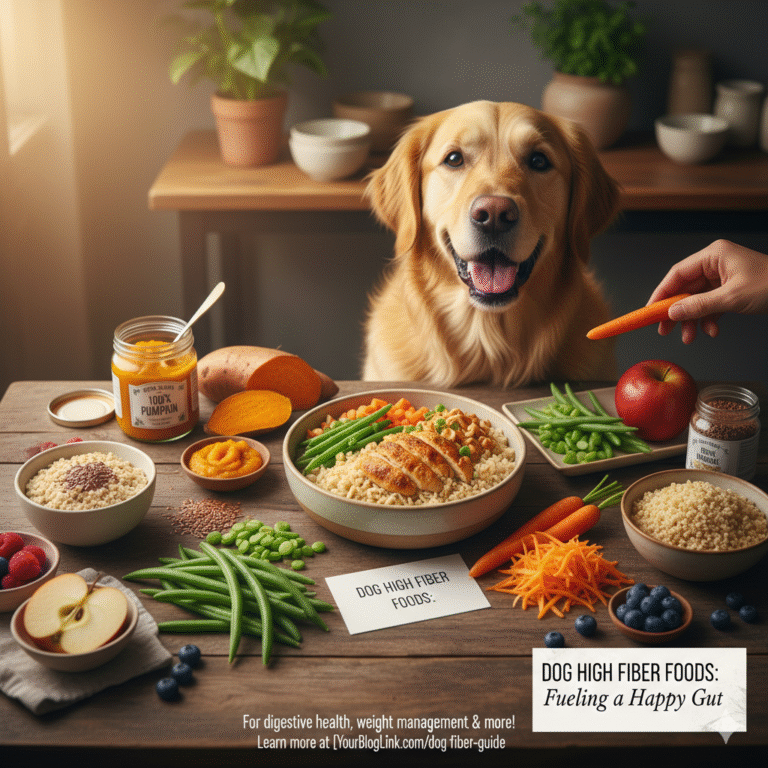
dog high fiber foods
Paws up if you’ve ever been mid-scoop and found yourself… well, studying your dog’s poop? Come on, you can admit it! We’ve all been there. You’re looking at it, wondering, “Is that too soft? Too hard? What does this masterpiece mean for my best friend’s health?”
Hey there, fellow dog parent! I’m so glad you’re here. Let’s have a real chat about something that doesn’t get nearly enough glamorous attention, but is a total rockstar for our furry family members: fiber. Now, I know, when we think about our own health, fiber is that thing our doctor tells us to eat for, ahem, “keeping things moving.” But guess what? It’s just as crucial for our four-legged pals!
It’s so easy to get swept up in the big debates about protein and grains, but high fiber foods for dogs often gets left in the dust. And that’s a real shame, because getting the right amount into your pup’s bowl can be a total game-changer for their digestion, their waistline, and even some specific health grumbles.
Think of high fiber dog food as the unsung hero of the digestive system, quietly working its magic behind the scenes. In this ultimate guide, we’re going to dig deep into the wonderful world of high-fiber foods for dogs. We’ll sniff out what fiber actually is, why it’s so pawsitively important, and how you can make sure your best friend is getting their fill. From delicious, whole food toppers to knowing when it’s time to call in the vet, we’ve got you covered. So, grab your favorite mug of coffee, give your pup a good scratch behind the ears, and let’s get this tail-wagging journey started!
I. Understanding High Fiber for Dogs
What exactly is dietary fiber for dogs?
Okay, let’s break it down. You know that super satisfying feeling after you eat a big, crunchy apple or a warm bowl of oatmeal? That happy, full feeling and the smooth digestion that follows? Yep, that’s higher fiber dog food doing its thing! For our dogs, it’s incredibly similar.
Dietary fiber is basically the indigestible part of plant foods – think of it as the tiny, structural scaffolding inside fruits, veggies, and grains. Now, don’t let the word “indigestible” fool you! While proteins, fats, and carbs get broken down for fuel, fiber is like the ultimate multitasker that works its magic as it travels through your pup’s system. It’s not just boring bulk; it’s the secret ingredient for a happy, balanced gut.
Why is fiber important in a dog’s diet?
So, why should we be so obsessed with something our dogs can’t even digest? Because, my friend, fiber is a total overachiever in the wellness department. As the amazing holistic vet Dr. Karen Becker often says, diversity is key in a diet, and fiber is a huge part of that.
First and foremost, it’s the champion of digestive regularity. It helps keep everything moving along at just the right pace, preventing both constipation and the dreaded diarrhea dash. Imagine it as a gentle, internal broom, sweeping through the intestines and keeping the traffic flowing.
But wait, there’s more! Certain types of fiber are what we call prebiotics. This is a fancy word for saying they’re like a gourmet feast for the good bacteria living in your dog’s gut. And a thriving community of good gut bugs (the microbiome) is absolutely essential for everything from absorbing all the good stuff from their food to supporting a robust immune system. A happy gut truly equals a happier, healthier dog!
What are the benefits of high-fiber dog food?
The perks of adding a little more fiber to your dog’s bowl are seriously impressive. It can make a noticeable difference in their day-to-day vitality. Let’s unpack the big ones:
- Improved Digestive Health: This is the headline act! Fiber adds beautiful bulk to stool, which can help firm up those messy, loose stools and also gently ease constipation. It’s nature’s perfect regulator for consistent, healthy poops.
- Weight Management: Is your pup carrying a few extra winter chubbies? Fiber can be your new best friend. High-fiber foods often have fewer calories but help dogs feel fuller and more satisfied after meals. This can mean less begging and fewer “I’m starving” eyes aimed at your dinner plate. Dr. Ernie Ward, a vet who is a rockstar in the fight against pet obesity, frequently recommends upping fiber as a key part of a weight loss plan.
- Blood Sugar Regulation: For our diabetic doggos, fiber can be a true lifesaver. Soluble fiber, in particular, helps slow down how fast sugar gets absorbed into the bloodstream, which leads to much more stable blood glucose levels.
- Anal Gland Health: Okay, let’s talk about the elephant in the room—or rather, the glands under the tail. Healthy, well-formed stools help naturally express those anal glands when your dog does their business. If the poop is too soft or too hard, these glands can get blocked and uncomfortable. Fiber is the key to achieving that Goldilocks “just right” stool consistency.
- Detoxification: Fiber is like a little detoxing ninja. It can bind to some nasty toxins in the gut and help usher them out of the body, preventing them from being reabsorbed.
- Reduced Risk of Certain Diseases: While science is always learning, a thriving gut microbiome, supported by fiber, is linked to a stronger immune system and may even help lower the risk of certain cancers.
Can too much fiber be bad for dogs?
You bet. Just like with too many dog treats, you can have too much of a good thing. While fiber is fantastic, going overboard can lead to some seriously stinky side effects.
Imagine eating nothing but bran muffins all day long – you’d be feeling pretty gassy and bloated, right? Our pups are no different. Too much fiber can cause:
- Gas and Bloating: This is usually the first, and smelliest, clue that you’ve been a bit too generous.
- Diarrhea or Loose Stools: It seems weird, right? While fiber helps with diarrhea, an absolute avalanche of it can actually cause the runs, especially if you introduce it too quickly.
- Reduced Nutrient Absorption: In very high amounts, fiber can sometimes bind to important minerals and vitamins, blocking your dog from getting all the nutritional goodness from their food.
- Increased Stool Volume: While good for regularity, excessively bulky stools mean one thing for you: more poop bags to carry on your walks!
The goal is to find that perfect sweet spot – enough fiber to get all the amazing benefits without any of the uncomfortable downsides. Always, always introduce new fibrous foods slowly and keep a close eye on your pup.
What’s the difference between soluble and insoluble fiber for dogs?
This is where we get a little science-y, but stick with me! Understanding these two types is like knowing the difference between a raincoat and an umbrella—they both keep you dry, but in different ways. Think of them as fiber’s dynamic duo with different superpowers!
Soluble Fiber
- What it does: This is the social butterfly of fiber! It dissolves in water and turns into a soothing, gel-like substance in the gut.
- Its superpowers:
- Slows Digestion: This gel slows everything down, which is fantastic for nutrient absorption and keeping blood sugar levels on an even keel. A must for diabetic dogs!
- Feeds Good Bacteria (Prebiotic): It’s a five-star meal for the beneficial bacteria in your dog’s gut, helping that microbiome flourish.
- Helps with Diarrhea: By soaking up excess water, it acts like a sponge to firm up loose stools.
- Good for Cholesterol: In humans, it’s a champ for this, though it’s less of a focus for our canine buddies.
- Where to find it: Oats, barley, psyllium husk, apples (sans seeds, please!), bananas, carrots, sweet potatoes, pumpkin, and flaxseed.
Insoluble Fiber
- What it does: This is the tough, no-nonsense fiber. It doesn’t dissolve in water; it stays intact from bowl to backyard.
- Its superpowers:
- Adds Bulk: It’s the ultimate stool-bulking agent, which helps get the intestinal muscles moving.
- Promotes Regularity: If your dog is a little backed up, this is your go-to. It’s the “roughage” that scrubs the intestines clean and keeps things truckin’.
- Aids in Satiety: All that bulk helps your dog feel wonderfully full, which is a huge help for weight management.
- Where to find it: Whole grains like brown rice and wheat bran, leafy greens, celery, green beans, fruit skins, and the stringy parts of veggies.
Most high-fiber foods have a mix of both, but one usually takes the lead. A balanced diet gives your pup the best of both worlds for ultimate digestive harmony!
II. Identifying High-Fiber Foods
Alright, now for the really fun part – what can we actually feed our dogs to give their fiber intake a boost? Mother Nature has provided us with a whole pantry of delicious and healthy options!
What natural foods are good sources of fiber for dogs?
When you’re looking to add fiber, think fresh and whole. So many of the fruits, veggies, and grains we have in our own kitchens are packed with the good stuff. Here are my top picks:
- Pumpkin: This is the Beyoncé of dog-friendly fibers. Canned pumpkin puree (and I mean 100% pumpkin, not the pie filling!) is a miracle worker for both diarrhea and constipation. It’s a beautiful blend of both soluble and insoluble fiber.
- Sweet Potatoes: Cooked and mashed, these orange wonders are a hit with most pups. They’re loaded with fiber, plus a bunch of vitamins.
- Green Beans: A low-calorie, crunchy snack that’s high in fiber. My dog goes nuts for them frozen on a hot day!
- Carrots: Another crunchy favorite, carrots offer a great fiber punch along with beta-carotene. Raw or cooked, they’re a win.
- Apples: (Remember, no core or seeds!) A fantastic source of fiber, especially in the skin. A few slices make a perfect, refreshing treat.
- Oats: Plain, cooked oatmeal (no sugar or funky flavors) is a gentle source of soluble fiber, perfect for sensitive tummies.
- Brown Rice: Cooked brown rice provides great insoluble fiber and is a staple in many bland diets for upset stomachs.
- Flaxseed: Ground flaxseed is a powerhouse, offering both soluble fiber and omega-3s. A little sprinkle does the trick.
- Psyllium Husk: This is like soluble fiber in its most concentrated form. It’s super effective but should be used with care and lots of water.
Which fruits and vegetables are high in fiber and safe for dogs?
Let’s get specific! Here’s a handy list of tasty, safe fruits and veggies your dog will probably love:
Fruits:
- Apples: Core and seeds removed! A few slices are perfect.
- Bananas: In moderation, these are a great source of fiber and potassium.
- Pears: Just like apples, make sure the core and seeds are gone.
- Blueberries: Tiny, delicious, and packed with antioxidants and fiber.
- Raspberries: Also high in antioxidants and a good fiber boost.
Vegetables:
- Pumpkin: The GOAT. We have to mention it again.
- Sweet Potatoes: Cooked and plain, please.
- Green Beans: Raw, steamed, or frozen—they’re all great.
- Carrots: My dog’s personal fave.
- Broccoli: In small amounts, as too much can lead to a gassy pup. Steamed is best.
- Spinach: A nutrient-dense leafy green, best in moderation.
- Asparagus: Cooked and chopped up small.
- Peas: Fresh or frozen, they’re a lovely source of fiber and vitamins.
- Kale: Like spinach, offer this one in small quantities.
Pawsitive Reminder: Always introduce any new food slowly and in tiny amounts to avoid tummy troubles. And when in doubt, a quick “is [this food] safe for dogs?” search is your best friend!
Are grains a good source of fiber for dogs?
Yes, indeed! Many whole grains are excellent sources of fiber for our canine companions. Now, I know grains can be a hot topic in the dog world, but for most dogs, they are not only digestible but also provide valuable nutrients, including fiber.
Here are some fiber-rich grains that are safe and beneficial (when cooked properly and given in moderation):
- Oatmeal: Plain, cooked oatmeal is a stellar source of soluble fiber. It’s like a warm hug for a sensitive stomach and is great for blood sugar regulation.
- Brown Rice: A classic source of insoluble fiber, brown rice adds wonderful bulk to stools and helps with regularity. You’ll see it in lots of commercial foods.
- Barley: This whole grain offers a mix of both soluble and insoluble fiber, plus B vitamins. It’s a solid choice for a balanced diet.
- Quinoa: Technically a seed, but we treat it like a grain! It’s a complete protein and provides good fiber, magnesium, and iron.
- Sorghum: A gluten-free grain that brings fiber and antioxidants to the bowl.
A Little Word of Caution on Grains:
- Allergies: While not super common, some dogs can be sensitive or allergic to grains like wheat. If you see digestive upset or itchy skin after introducing a new grain, have a chat with your vet.
- Cooking is Key: Grains must be thoroughly cooked for dogs to digest them. Raw grains are a no-go.
- Moderation Matters: Grains are calorie-dense, so they should be part of a balanced diet, not the whole show.
For many dogs, including healthy grains is a simple and effective way to bump up that fiber intake.
What commercial dog foods are high in fiber?
If you’re looking for a convenient all-in-one solution, many commercial dog food brands make recipes with higher fiber content. You’ll often find these labeled as “weight management,” “senior,” or “digestive health” formulas.
When you’re on the hunt for a high-fiber kibble, look for these ingredients on the label:
- Whole Grains: Brown rice, barley, oats, quinoa.
- Veggies & Fruits: Pumpkin, sweet potato, peas, beet pulp (a super common and effective fiber source in dog food, despite its funny name).
- Legumes: Lentils, chickpeas.
- Specific Fiber Additives: Psyllium husk, flaxseed.
Brands to Peek At (always double-check the ingredient list and guaranteed analysis!):
- Purina Pro Plan Veterinary Diets EN Gastroenteric Fiber Balance: This one often comes highly recommended by vets for specific tummy troubles.
- Royal Canin Veterinary Diet Gastrointestinal High Fiber: Another vet-prescribed option for serious digestive support.
- Hill’s Prescription Diet w/d: Formulated for weight management, diabetes, and conditions that respond well to fiber.
- Many “Weight Control” or “Senior” Formulas: These usually have higher fiber to help older or less active pups feel full and stay regular.
My Pro Tip: Don’t just fall for the marketing on the front of the bag. Flip it over and check the “Guaranteed Analysis” for the crude fiber percentage. While 5-10% is generally considered high for dry food, your vet is the best person to help you decipher those numbers for your unique dog.
Can I add fiber to my dog’s regular food? If so, how?
You absolutely can! This is my favorite way to customize my dog’s diet. It lets you gradually increase their fiber without doing a full food switcheroo, which can be tough on sensitive stomachs.
Here’s my step-by-step guide to safely pumping up the fiber in your dog’s bowl:
- Start Teeny-Tiny: This is the most important rule! Introduce any new fiber source at a snail’s pace. Begin with a minuscule amount (think: a teaspoon for a medium-sized dog) and gradually nudge it up over a week or so. This gives your dog’s gut time to adjust and lets you watch for any funny business like gas or weird poops.
- Pick Your Powerhouse:
- Canned Pumpkin Puree (100% pumpkin): The ultimate superstar! Add a teaspoon or tablespoon (size-dependent) to meals. It’s tasty and works for both constipation and diarrhea.
- Cooked Sweet Potato: Mash a small spoonful and mix it in.
- Cooked Green Beans or Carrots: Chop them up fine or give them a steam and mash.
- Ground Flaxseed: A tiny sprinkle (like 1/2 to 1 teaspoon for a medium dog) gives a mix of fibers and omega-3s. Make sure it’s ground, as whole seeds just pass right through.
- Psyllium Husk: This is potent stuff. Use with extreme caution and in very small amounts (e.g., 1/4 teaspoon mixed with water for a medium dog). It’s best to get your vet’s okay before using psyllium long-term.
- Plain, Cooked Oatmeal: A spoonful or two mixed in adds gentle soluble fiber.
- Water, Water, Water!: Fiber needs to be well-hydrated to do its job properly. If you’re adding fiber, make sure the water bowl is always full and fresh. This is non-negotiable with psyllium.
- Mix It Up Good: Stir that fibrous topper evenly throughout your dog’s food so they get a little bit in every bite and don’t just get one big, gassy lump.
- Watch and Learn: Be a poop detective! Keep a close eye on your dog’s stool consistency, energy, and overall comfort. If you see more gas than a balloon factory or the poops get worse, dial back the amount or take a break and call your vet.
By slowly adding these natural, fiber-rich foods, you can seriously level up your dog’s digestive health and enjoy all the amazing benefits!
III. Health Conditions & Fiber
Fiber isn’t just for everyday wellness; it’s a legit powerful tool for managing specific health conditions. Let’s look at how it can help.
How does fiber help with dog diarrhea?
I know, it sounds backwards, right? How can something that adds bulk help with the runs? But trust me, it’s magic. Here’s the scoop on poop:
- Soluble Fiber’s Superpower: Soluble fiber (from pumpkin, oats, psyllium) is like a super-sponge. It soaks up all the excess water in the digestive tract, which helps to bulk up and firm those loose, watery stools.
- Prebiotic Power-Up: Soluble fiber also feeds the good gut bacteria. Diarrhea can really throw that bacterial balance out of whack, so helping the good guys thrive helps the whole gut heal and get back to normal.
- Slowing the Flow: The gel that soluble fiber creates slows down how fast food zips through the intestines. This gives the body more time to absorb water and nutrients, which is exactly what’s needed during a bout of diarrhea.
My Go-To Move: Plain, 100% canned pumpkin puree is my first line of defense for a slightly upset tummy. A tablespoon or two mixed into their food can often clear things up in no time.
related: Dog Diarrhea: Causes, Fixes, & When to Worry
Is high fiber food good for dog constipation?
high fiber dog food for constipation
Oh, yes! This is probably fiber’s most famous claim to fame.
- Insoluble Fiber to the Rescue: Insoluble fiber (from green beans, carrots, whole grains) is the ultimate stool-bulker. This bulk gives the intestinal muscles something to push against, getting things moving again.
- Holding onto Water: While it doesn’t dissolve, insoluble fiber can help retain water in the stool. This keeps everything soft and moist, making it much easier to pass.
- Nature’s Laxative: By making the stool bigger and softer, fiber provides a gentle, natural way to relieve constipation without needing harsh medications.
My Go-To Moves: Canned pumpkin works here too! Also, small amounts of cooked sweet potato, green beans, or a sprinkle of ground flaxseed are fantastic. And don’t forget the water!
related: Best Dog Food for Digestive Upset
Can fiber help dogs with anal gland issues?
This is a huge one that doesn’t get talked about enough at the dog park! Anal gland issues are so common and so uncomfortable for our pups.
- The Natural Squeeze: A dog’s anal glands are designed to be naturally expressed when they pass a firm, well-formed stool. The pressure from the poop does the job for them!
- Fiber’s Role: A fiber-rich diet is the key to creating that perfect, expressible poop. If the stool is too soft (from low fiber or other issues), it just squishes without applying pressure, leading to blocked and irritated glands. If it’s too hard, it’s painful to pass and also doesn’t help.
- The “Goldilocks” Poop: Fiber helps you hit that sweet spot—firm enough for a good squeeze but soft enough to pass comfortably.
Many holistic vets, like the wonderful Dr. Judy Morgan, often suggest looking at dietary fiber first for dogs with recurring anal gland drama before jumping to manual expressions.
Does fiber aid in dog weight management?
Fiber is a total MVP when it comes to helping our pups slim down.
- The Fullness Factor: High-fiber foods help dogs feel full and satisfied without a ton of calories. The fiber adds bulk to the food and can slow down how quickly the stomach empties. A full belly tells the brain, “We’re good here!” which cuts down on begging.
- Low-Calorie Swaps: Many fiber-rich veggies (looking at you, green beans and carrots!) are super low in calories. Replacing some of their regular kibble or high-cal treats with these can significantly cut their daily calorie intake without them even noticing.
- Blood Sugar Stability: Soluble fiber helps prevent those blood sugar spikes and crashes that can leave your dog feeling hungry and searching for snacks.
For a chunky pup, adding more fiber to their diet, alongside measured portions and good exercise, is a foundational part of a successful weight loss journey.
Is high fiber food beneficial for diabetic dogs?
100% yes! Fiber can be a critical part of managing diabetes in dogs.
- Blood Sugar Control: Soluble fiber is the star here. It slows down the digestion process, which in turn slows down the absorption of glucose (sugar) into the blood. This means no crazy sugar spikes after meals—just a nice, steady, manageable rise.
- Better Insulin Sensitivity: By promoting stable blood sugar, fiber can help the body use insulin more effectively over time.
- Weight Control: Since many diabetic dogs are also overweight, the weight management benefits of fiber are a double win.
Vets often prescribe special high-fiber diets for diabetic dogs to help maintain those crucial stable blood glucose levels and can sometimes even reduce the amount of insulin needed.
How can fiber help a dog with inflammatory bowel disease (IBD)?
IBD is a tough, complex condition, and diet is a massive piece of the puzzle. Fiber can play a really supportive role.
- Gut Buddy Support: Soluble fiber, as a prebiotic, is like fertilizer for the good gut bacteria. In IBD, the microbiome is often out of balance, so feeding the beneficial bugs can help calm inflammation and repair the gut lining.
- Butyrate Production: This is a cool bit of science! When good bacteria munch on soluble fiber, they produce short-chain fatty acids, including one called butyrate. Butyrate is like super-fuel for the cells lining the colon and has powerful anti-inflammatory effects, which is exactly what an IBD gut needs.
- Bulking Agent: For IBD dogs suffering from chronic diarrhea, fiber can help add bulk and form to their stools, giving them more control and comfort.
However, finding the right fiber for an IBD dog can be a delicate dance. Some do brilliantly with more soluble fiber, while others might react badly to certain types. This is one time where it’s essential to partner with your vet or a veterinary nutritionist. They can help you pinpoint the perfect fiber sources and amounts for your dog’s unique situation.
IV. Practical Considerations & Usage
Alright, we know the “why,” now let’s get into the nitty-gritty “how” of making fiber work for your dog.
How much fiber does a dog need daily?
There’s no single magic number for every dog. The perfect amount depends on your dog’s age, size, activity level, and health. But here are some general guidelines:
- Standard Kibble: Most regular adult dog foods have a crude fiber percentage of around 2-5%.
- Therapeutic Needs: For dogs with specific issues like diabetes or obesity, a vet might recommend a diet with 5-10% crude fiber or more. Some prescription diets go even higher.
- General Supplementing: When adding natural foods, a little goes a long way. For a medium dog, think 1-2 tablespoons of pumpkin or green beans, or 1-2 teaspoons of ground flaxseed per meal.
- Talk to Your Vet: This is the best advice I can give. Your vet can give you a personalized target. As Dr. Cathy Alinovi often highlights, every dog’s nutritional plan should be as unique as they are.
The goal is to support their health, not to overwhelm their system.
What are the signs that my dog needs more fiber?
Your dog has a way of telling you what they need—you just have to know how to listen! Here are some clues that your pup might be begging for a fiber boost:
- Constipation: Straining to go, producing little, hard rocks, or not going very often.
- Chronic Diarrhea or Soft Stools: Ongoing messy poops can signal a need for soluble fiber to firm things up.
- Anal Gland Issues: Scooting, licking their bum, or needing frequent manual expressions from the groomer or vet.
- Weight Struggles: If your dog always seems hungry or can’t seem to lose weight, fiber can help them feel full.
- Diabetes Diagnosis: If your dog becomes diabetic, fiber will be a key part of their management plan.
- Constant Begging: Sometimes this is just a bad habit, but sometimes it’s a sign they aren’t truly satisfied after meals.
- Dull Coat: While not a direct sign, a unhealthy gut can show up in a poor coat. A fiber-rich, healthy gut can lead to a shinier pup!
How should I introduce high-fiber foods to my dog’s diet?
Slow and steady wins the race every single time! A dog’s digestive system is sensitive and does not like sudden changes.
- The Pinky-Nail Rule: Start with an amount so small it’s about the size of your pinky nail. For pumpkin, that might be a teaspoon for a small dog or a tablespoon for a large one.
- The Gradual Climb: Over the next 5-7 days, slowly, slowly increase the amount. Watch your dog like a hawk. If they’re handling it well, you can nudge the amount up a little every other day.
- Become a Poop Detective: Your dog’s stool is your report card. You’re looking for improvement. If things get too loose or too hard, or if the gas is unbearable, scale it back.
- Water is Non-Negotiable: Fiber needs water to work. Make sure that water bowl is always clean and full.
- One at a Time: If you’re trying a few new foods, introduce them one by one. That way, if there’s a reaction, you know the culprit.
- Vet Chat: Before any major diet shift, especially with a dog who has health issues, a quick call to your vet is always the smartest move.
Are there any side effects of increasing fiber in a dog’s diet?
While fiber is mostly amazing, too much too fast can cause some temporary hiccups (or toots!). These usually settle down once you find the right amount.
- Gas (The Toots): This is public enemy number one. As the gut bacteria adjust to the new fiber feast, they produce gas. It should get better as your dog’s system adapts.
- Bloating/Tummy Discomfort: All that gas and bulk can make your pup feel a bit pot-bellied and uncomfortable.
- Stool Consistency Changes:
- Too Loose: Too much soluble fiber, too fast, can actually cause diarrhea.
- Too Hard: If there isn’t enough water with high fiber, it can make constipation worse, especially with dry supplements like psyllium.
- Bigger Poops: More fiber in = more fiber out. Be prepared for more to clean up!
- Reduced Appetite: In some cases, if a dog feels overly full, they might not finish their meal.
- Nutrient Blocking: At extremely high levels, fiber could theoretically bind to minerals and stop them from being absorbed. This is why balance is everything.
If side effects are severe or don’t go away, cut back on the fiber and give your vet a ring.
related: Bland Diet for Dogs with Diarrhea or Colitis & pancreatitis
When should I consult a vet about my dog’s fiber intake?
It’s always better to be safe than sorry! Here’s when to pick up the phone and call your vet:
- Ongoing Tummy Troubles: If diarrhea, constipation, or anal gland issues just won’t quit, even with dietary changes.
- Pre-Existing Conditions: If your dog has diabetes, IBD, kidney disease, or anything else major, always loop your vet in on diet talks.
- Weight Loss Plan: For a structured and safe weight loss program for an overweight dog.
- Bad Reactions: If your dog has bad gas, bloating, vomiting, or worse poop after a fiber increase.
- No Improvement: If you’ve been consistently adding fiber for a while and see zero positive changes.
- You’re Just Not Sure: If you’re confused about amounts or sources, your vet is your guide.
- Using Strong Supplements: For concentrated stuff like pure psyllium husk, get professional guidance on dosage.
Your vet has the whole picture of your dog’s health and can give you the perfect, personalized plan.
What are the best high-fiber treats for dogs?
Healthy treats can be delicious, I promise! Here are some fantastic high-fiber options your dog will go nuts for:
- Plain, Cooked Green Beans: A classic! Low-cal, crunchy, and full of insoluble fiber.
- Carrot Sticks or Baby Carrots: Perfect for crunching and great for teeth.
- Apple Slices: (No core/seeds!) A sweet, juicy, fibrous reward.
- Blueberries & Raspberries: Tiny power-packed bites. Perfect for training.
- Canned Pumpkin Puree: A dollop on a Lickimat or frozen in a Kong is an epic, fiber-filled treat.
- Cooked Sweet Potato Chunks: Soft, sweet, and beloved. Just make sure they’re plain.
- Store-Bought High-Fiber Treats: Look for treats that list oats, flaxseed, or pumpkin high on the ingredient list. “Dental” or “weight control” treats are often higher in fiber.
Homemade Fiber Treats:
You can also be a superstar and bake your own! A quick search will find tons of recipes for dog biscuits using pumpkin, oats, and flaxseed. It’s fun and you control everything that goes in!
Remember, treats are just that—treats! They should make up no more than 10% of your dog’s daily calories, especially if they’re watching their waistline.
So, there you have it! A complete, down-to-earth guide to fiber for our furry best friends. We’ve covered everything from the different types of fiber and the best food sources to how it can help with everything from the squirts to the squats!
Just remember, every single dog is one of a kind. What works for the Labrador next door might not be perfect for your Poodle. The trick is to be patient, watch closely, and never hesitate to partner with your veterinarian. They’re your ultimate resource for creating a diet that helps your specific dog thrive.
By paying a little extra attention to fiber, you’re doing so much more than just helping with digestion. You’re actively investing in their overall health, happiness, and the long, waggy-tailed years you have together. So go on, share a green bean, mix in a little pumpkin, and give your best friend the gift of a happy, healthy tummy. Cheers to our amazing dogs!
FAQs About Dog High Fiber Foods
Q1: Can I give my dog too much pumpkin?
A: You sure can. While pumpkin is pawsome, too much can lead to a fiber overload, causing gas, bloating, or even diarrhea. Stick to the recommended small amounts.
Q2: What’s the best high-fiber food for an overweight dog?
A: Low-calorie, high-fiber veggies like green beans, carrots, and plain pumpkin are perfect toppers. Many commercial “weight control” kibbles are also formulated with higher fiber. Your vet can help you build the best plan.
Q3: Is it better to give soluble or insoluble fiber for diarrhea?
A: Reach for soluble fiber (pumpkin, psyllium, oats) for diarrhea. It’s the champ at absorbing excess water and firming things up.
Q4: How quickly should I see results after adding fiber for constipation?
A: For a simple case, you might see a change within a day. For more chronic issues, give it a few days of consistent fiber and water. If nothing happens, call your vet.
Q5: Can I give my dog fiber supplements meant for humans?
A: It’s not the best idea without a vet’s thumbs-up. Human supplements like Metamucil can be used, but the dose for dogs is tiny and needs to be managed carefully. Always choose plain, unflavored versions if your vet okays it.
Q6: Are fruits like berries good sources of fiber for dogs?
A: Yes! Berries like blueberries and raspberries are safe, healthy, and provide a nice little fiber and antioxidant boost. Perfect as a tiny treat.
Q7: My dog is gassy after I added fiber. What should I do?
A: A little gas is normal at first. Just reduce the amount you’re giving and slowwww down the increase. If it’s truly epic, stop and check in with your vet.
Q8: Does high fiber food help with bad breath in dogs?
A: Not directly. Bad breath is usually a dental hygiene issue. However, if the bad breath is linked to digestive problems, then a healthier gut from fiber might indirectly help a little. But you still need to brush those teeth!
Q9: Can puppies have high-fiber foods?
A: Puppies have special nutritional needs for growth. Their main diet should be a quality puppy food. Tiny amounts of fiber-rich foods like pumpkin can be introduced carefully, but always ask your vet what’s right for your growing pup.
Q10: What kind of oats are best for dogs?
A: Plain, rolled oats (old-fashioned or quick-cook) that you cook in water are perfect. Avoid the instant packets with added sugars and flavors.
please leave comment
you may like it





sources
- https://www.iams.com/dog/dog-articles/why-fiber-your-dogs-food (iams.com)
- https://www.dogfoodadvisor.com/canine-nutrition/dog-food-fiber-part-2/ (Dog Food Advisor)
- https://www.akc.org/expert-advice/nutrition/benefits-high-fiber-dog-foods/ (American Kennel Club)
- https://www.petmd.com/dog/nutrition/evr_dg_whats_in_a_balanced-dog-food (petmd.com)
- https://www.dvm360.com/view/role-fiber-weight-loss-diets (dvm360.com)
- https://www.petscare.com/news/faq/what-is-the-healthiest-fiber-for-dogs
- https://www.purina.com/articles/dog/health/nutrition/benefits-fiber-dogs
- https://www.petfoodindustry.com/nutrition/research-notes/article/15712189/dog-microbiome-boosted-by-higher-dietary-fiber
- https://www.mdpi.com/2076-2615/12/5/627
- https://www.petfoodindustry.com/nutrition/article/15450647/fiber-focus-fiber-in-pet-food
- https://pubmed.ncbi.nlm.nih.gov/38254365/

